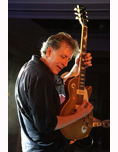Blues Power - Shuffling On: Shuffle Rhythm Patterns


The shuffle feel is the essence of the blues. Every blues guitarist should know how to play at least a couple of different shuffle comp (accompaniment) patterns. I'd like to introduce you to three basic patterns that you can solo over. The shuffle is based on a triplet rhythm with the middle note missing. To get a shuffle, first tap your foot at a medium tempo and play three notes for every beat. Then take out the middle note, leaving the first and third. This lopsided feel is the shuffle. For simplicity's sake, shuffle rhythms are often written using straight eighth notes with an indication to play with a shuffle or swing feel (TAB FIGURE 1).
The first comp pattern (TAB FIGURE 2) is one that most people learn early on. The trick is to play it right. Here are a few pointers to help you nail it:

- 1) Use all downstrokes, except for the last chord.
- 2) Accent the downbeats (the beat where your foot hits the floor).
- 3) Mute the strings slightly with the heel of your picking hand.
- 4) "Bounce" with your fretting hand, applying pressure on the downbeats and releasing it on the upbeats.
Apply this same feel to a 12-bar blues in E (TAB FIGURE 3). The A chord fingering is similar to the fingering used on the E chord, except it's based on the open A string. The B chords, however, require the use of the first finger for the root note. The second and fourth fingers reach for the other notes.
For a good example of this style, listen to Jimmy Vaughan with the Fabulous Thunderbirds. Jimmy Reed and Eddie Taylor, two Chicago blues artists who recorded both together and separately, are also fine practitioners of this shuffle feel.
The second shuffle pattern (TAB FIGURE 4) is a filled-out version of the first. This one's great for "opening up" the rhythm behind a soloist. Follow the above shuffle guidelines, but don't mute the strings with your picking hand. Let the notes sound clearly. Do be careful, however, to mute the fifth string with your fretting hand. For the more adventurous, mute the sixth string by allowing your thumb to hang over the top of the neck. This will enable you to whack the strings with the pick without worrying about sounding any unwanted open notes. Another thing you can do is use the thumb to fret the root notes of the A and B chords on the sixth string. Robert "Junior" Lockwood, a Chicago blues guitarist (and stepson of Robert Johnson) uses this comp pattern frequently.
The last pattern (TAB FIGURE 5) is a driving groove based on a boogie-woogie piano riff. In this case, the guitar takes the place of the pianist's right hand, playing only on the upbeats. To get the right feel, mute the strings with the heel of your picking hand between each upbeat so no sound is produced, then attack each chord on the upbeat with an upstroke. If you're practicing this pattern by yourself, try recording FIGURE 2 onto a four-track machine or your computer, then play FIGURE 5 along with the recording. The first pattern will provide the solid downbeats. For examples of this last comp style, listen to T-Bone Walker, the original electric blues guitar star.
All the latest guitar news, interviews, lessons, reviews, deals and more, direct to your inbox!
